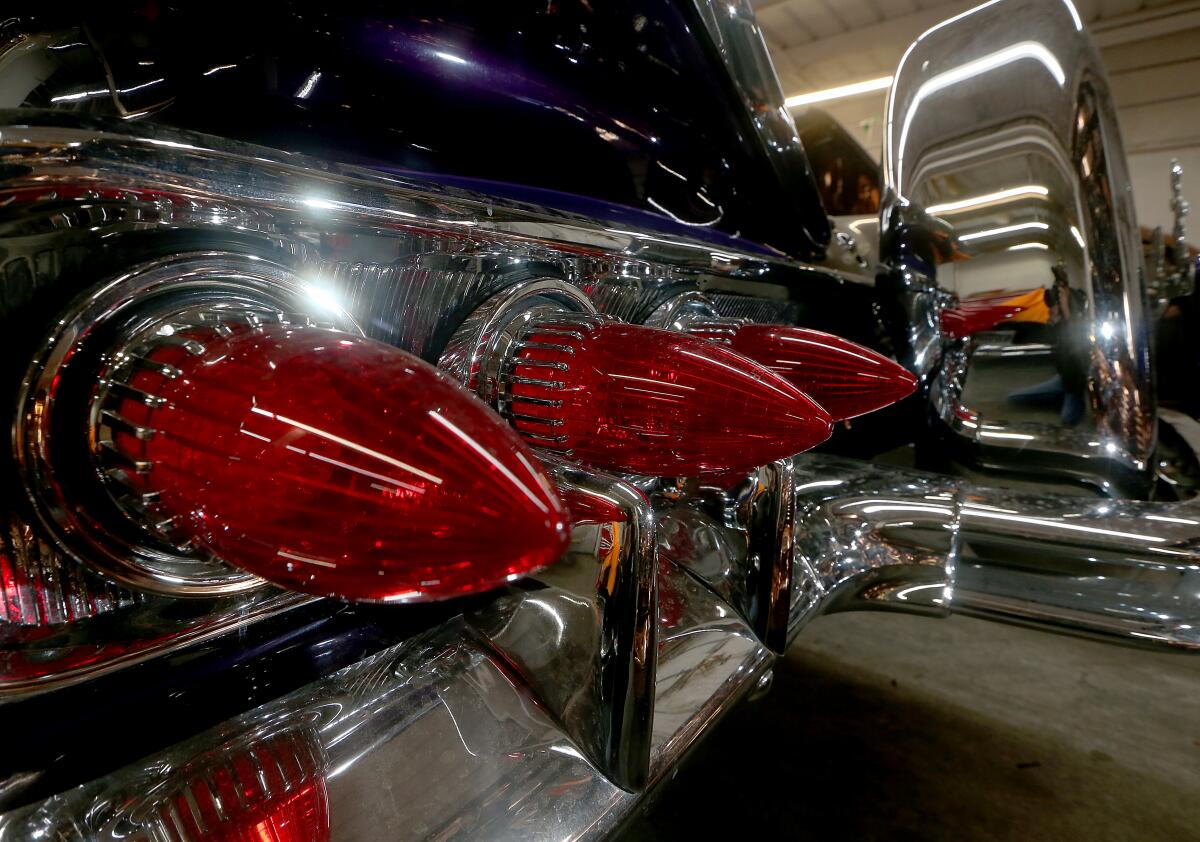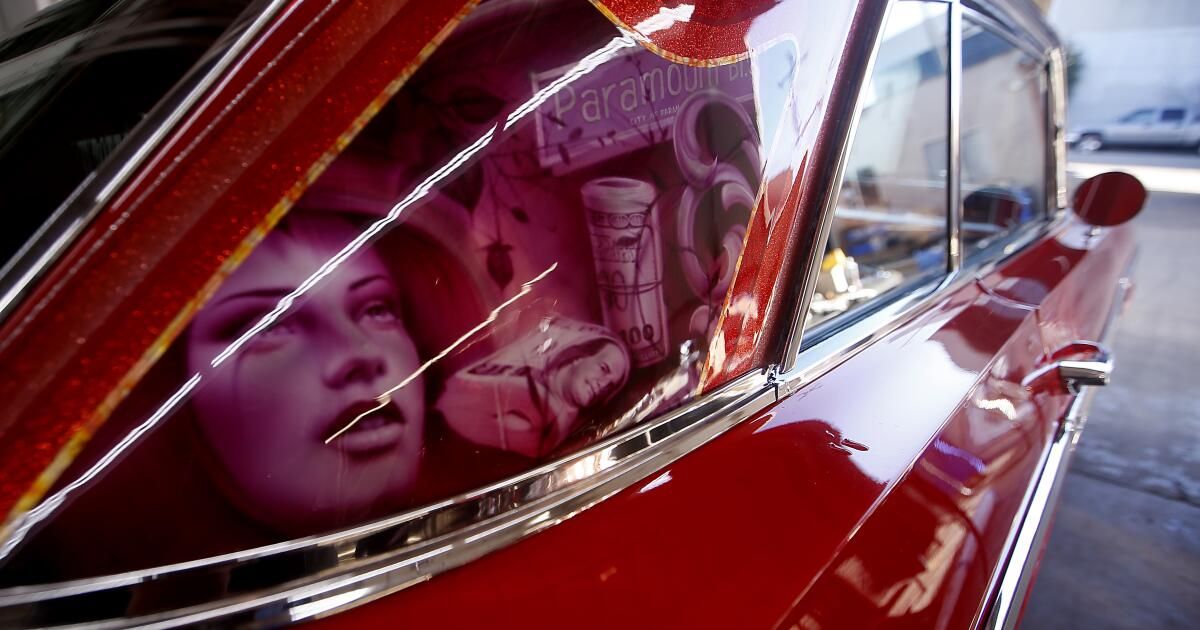For as long as he can remember, he has dedicated the entire card to Luis “Speedy” Rodríguez.
Growing up in his native Mexico City, he confessed: “I wouldn't get on buses if they weren't fixed“ — tricked
After migrating to the United States as a teenager, Rodríguez wanted to work at a chrome plating facility so badly that he started cleaning bathrooms and delivering parts. Free.
All these decades later, Rodríguez, now 50, is a chrome legend. His filigree work decorates hundreds of lowriders throughout Southern California. His cars have appeared in Audi commercials, Travis Scott music videos and Hollywood movie promotions.
Rodriguez's “retirement” is a collection of Chevrolet Impalas from 1958 to 1964 (the iconic model's best years) stored in a garage at his business, Speedy's Metal Finishing in Long Beach. They're coated in enough shiny material (chrome, yes, but also copper, rose gold, stainless steel, and even 24-karat gold) to make the diamonds appear as shiny as a cardboard tube.
All around us were hundreds of chrome parts (bolts, coilovers, A-arms, gas tanks, tires) on the floor, on shelves, tables, and even offices.
“Chrome is magical,” Rodriguez said as we walked through his complex. “When you see it in a car, it's inexplicable.”
I agree. When I look at the grille of my 1974 Cadillac Eldorado convertible, it's like a portal to another world, one where everything shines, hard-working people take care of what they own, and life is just a cruise ship.
I visited Rodriguez hoping to see a rusty bumper transformed into a gleaming beauty. But it now outsources that work to finishers in Santa Fe Springs and Fullerton. When I asked her why, she laughed.
“Oh, no,” Gonzalez responded. “They have to take care of everything. City. Fire brigade. OSHA, AQMD. Even if he had the money, he wouldn't do it. Let them take care of the headaches.”
A look under the hood of a customized Chevrolet Impala at Rodriguez's shop in Long Beach.
(Luis Sinco/Los Angeles Times)
Last month, the California Air Resources Board held a public hearing to discuss the use of hexavalent chromium, a compound that gives chrome-plated products (not just auto parts, but also faucets and appliances) their attractive shine. The finished product is harmless, but the plating process, which involves submerging parts in a chemical bath, produces air emissions 500 times more toxic than diesel emissions.
The Air Resources Board has heavily regulated hexavalent chromium in California since it was identified as a toxic air pollutant in 1986. Now, the board is considering an outright ban on its use by 2039. So-called decorative chromiums like Rodriguez would have to stop by 2027, because many operate near working-class neighborhoods. Silversmiths will have to switch to less toxic, less shiny and more expensive chrome plating materials, something Rodríguez doesn't think his peers and clients will accept.
We stood in front of a black 1960 Impala to admire the trim that extended along the side of the car. One half was chrome and the other stainless steel.
Which was which?
I guessed correctly: the stainless steel was a little more opaque. Only a gearhead could tell the difference. González explained that steel is much cheaper than chrome, but few customers ask for it.
“It's always about the bling” he explained with a sympathetic shrug.
The board will make its final decision in May. González was very serious when I asked him about the possible ban. “It's been talked about for years, so I'll believe it when he sees it,” he said. But the normally jovial man remained silent.
“This is the biggest part of my life. …It would be sad. There are people who have been doing this for many years and… boom! – jobless”. He noted that customers would simply ship parts to other states or drive to Tijuana.
“What makes it fun,” González concluded, “is [California] I wanted to legalize marijuana and now chrome is illegal. “Drugs are poison, but it's more respectable in California to sell drugs now.”
Banning carcinogenic pollutants is a noble cause. But the more I read the California Air Resources Board's 253-page report, the more I felt that its authors were committing two bureaucratic sins increasingly fashionable in Sacramento: creating a solution in search of a problem and losing the forest for the tree is.
Hexavalent chromium contamination is no joke. It was the contaminant of the trials that made Erin Brockovich famous. In the late 1990s, a cancer cluster emerged at Suva elementary and middle schools in Bell Gardens that led to a legal settlement against a nearby chromist. In 2017 and 2018, a Paramount company temporarily suspended some operations three times after exceeding hexavalent chromium levels set by the South Coast Air Quality Management District, a case study the board's report cited. .
I was hoping to find more examples like these that could justify the accelerated push against decorative chromes like González. But when I asked the board for statistics about the high cancer rates among Californians who live near those businesses, chief information officer Melanie J. Turner responded: “We don't know any data.” Turner also sent a statement from the California Office of Environmental Health Hazard Assessment admitting the same.
Both agencies emphasize the potential risks of any exposure near irons that use hexavalent chromium. But if the mere hint of danger is what drives the ban, then the California Air Resources Board is ignoring its own conclusions. Decorative and industrial chromium plating accounted for just 0.4% of all hexavalent chromium emissions in 2020 that board staff were able to track. Far worse polluters are lumber manufacturers, glass producers, and even the gas stoves that so many Californians use.
The biggest culprit by far? Vehicle exhaust and burning of fossil fuels.
So, why focus on decorative chrome? I asked González. Or why not just relocate them away from residents or simply require even more regulations?
“It's pure politics” he responded, using a phrase (it's pure politics) that the ranch libertarians in my life always use to explain political nonsense. “There are some better things we need to take care of.”
State lawmakers have targeted California's car culture for years in the name of environmental justice and fighting climate change. The Air Resources Board already voted last year to stop the sale of all new gasoline-powered cars by 2035. Lawmakers passed two laws aimed at combating noisy cars. Los Angeles is considering banning new gas stations.
All of these moves are well-intentioned. But they point to a way of life whose latest admirers and defenders are mostly working-class people of color: an easy sacrifice on the altar of saying you're saving the planet. The board admits as much: It predicts that banning hexavalent chromium in favor of more expensive alternatives “will result in greater competitive disadvantage and possible closures of chromium plating companies” and “negative impacts on employment.”
But oh well!

Rodriguez's “retirement” is a collection of Chevrolet Impalas from 1958 to 1964, the iconic model's best years, stored in a garage at his business, Speedy's Metal Finishing in Long Beach.
(Luis Sinco/Los Angeles Times)
Rodriguez's workers began to enter as I prepared to leave. They greeted Erasmo González, a winemaker who has been a client for a decade. He drove that morning from Delano to check parts on his 1975 Chevrolet Caprice convertible.
“I think they're full of it,” said the 42-year-old, who was wearing a Los Angeles Dodgers cap with his last name embroidered on the side. “Forest fires put all kinds of bad things in the air. Why don't they ban them?
Erasmus noted that air quality in Southern California has improved dramatically over the decades thanks to cleaner fuels and better engines, even as the population has increased and there are more vehicles on the roads than ever.
“Technology makes things better,” he said. “There is always a way to solve it. Don’t just ban after ban.”








